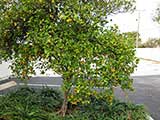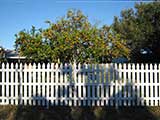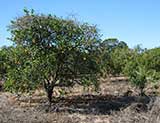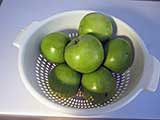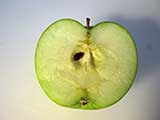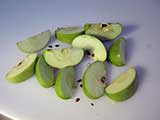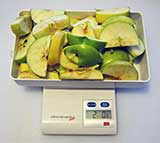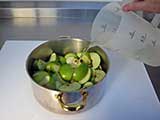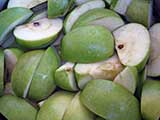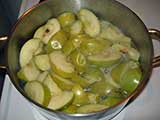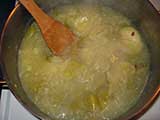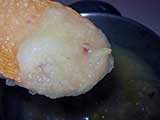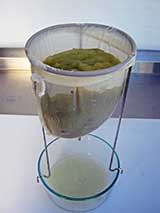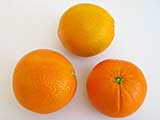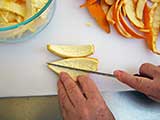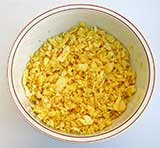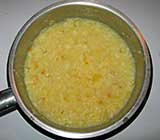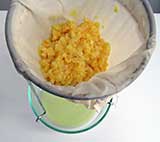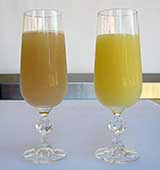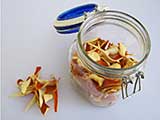Meats and Sausages
Making Pectin
Pectin can be made from any high pectin fruit: crabapples, apples, quinces, lemons or oranges. To extract pectin, the fruit must be first cooked. Commercial pectin is made from citrus peels or apples and in most cases comes in a powdered form, although a liquid pectin is also easily obtainable. If you intend to make your own pectin, look for fruit that is available for free. In cooler climates wild apples (crabapples) will be a good choice; in hot places like Florida, citrus fruits are so abundant that many people don't even bother to pick them up.
Pectin Made From Apples
Apples are the common choice as they are available over a wide range of climate zones, they are easy to prepare and the resulting pectin stock has a neutral flavor. It can be used in a wide variety of jams and jellies without affecting the natural flavor of the fruit.
Instructions
- 4 lbs. unripe apples
- 4 cups of water
To extract pectin obtain unripe fruit, mainly green and still slightly sour apples. Do not use sweet or fully ripe yellow or red apples.
Fill a large pot, and add enough water to almost cover the apple chunks. Excess water dilutes the pectin, flavor and color of the home made pectin and results in a longer cooking step.
Put the pulp into the jelly bag or line a large bowl with a damp cheesecloth. Suspend the jelly bag or cheese cloth over the bowl and leave to drain overnight or for 8-12 hours. Do not press, leave it undisturbed, otherwise it becomes cloudy. Perform the pectin alcohol test. Remember that the alcohol test does not work right if the pectin is hot. If the pectin is too thin, place it again in a saucepan and simmer more. Take a new sample, cool it and perform the alcohol test. Store in a refrigerator.
Pectin Made from Citrus Fruit
Pectin is concentrated mainly in the peel - in the white, inner part of the skin (pith), in the membranes between the sections and in the seeds. Citrus fruit produces a lot of super jelling pectin, but it has a pronounced flavor which comes from the slightly bitter pith. The membranes and seeds have a neutral flavor. Underripe fruit poseses thick skins and will produce more pectin than a fully matured fruit. The fully ripe fruit left on the tree will have even thinner skin and only a little pectin.
What follows below is the excellent formula for citrus pectin from an old document: Stennis, M.A., "Citrus Conservation" Florida Fruits and Vegetables in the Commercial Menu, State of Florida Department of Agriculture, Tallahassee, 1931.
- 1/2 lb white part (pith) of orange peel, about 8 oranges may be needed
- 1 pint (2 cups) of water
- 4 Tbsp. lemon juice
The more pronounced flavor of a lemon pectin base means it's most suited for a jam or jelly where you want the lemon flavor.
Instructions
Boil gently 10 minutes. Switch off the heat, cover and let the pot cool. Perform the pectin alcohol test.
Second extraction
After the pectin stock was drained away, the pulp can be mixed with 3/4 pint of water again and reboiled gently for 10 minutes. Then it should be cooled and drained. If the alcohol test shows that the pectin stock is too thin, it can be simmered for 10 minutes to evaporate some water. Both extractions may be mixed together.
If a pectin stock satisfies the alcohol test, it will gel and the jelly will set. Apple or orange pectin stock can be used for making apple or orange jelly, or it may be added to other fruits and juices that are pectin poor. For example, strawberries, pears, blueberries, and apricots are pectin poor and will benefit if a solid pectin stock is added. People knew nothing about pectin but it was a well known fact that it was easier to make strawberry pectin if some apples were added.
Dried Orange Skins
The leftover yellow skin is full of aroma and can be dried out in the sun, oven or the dehydrator.

